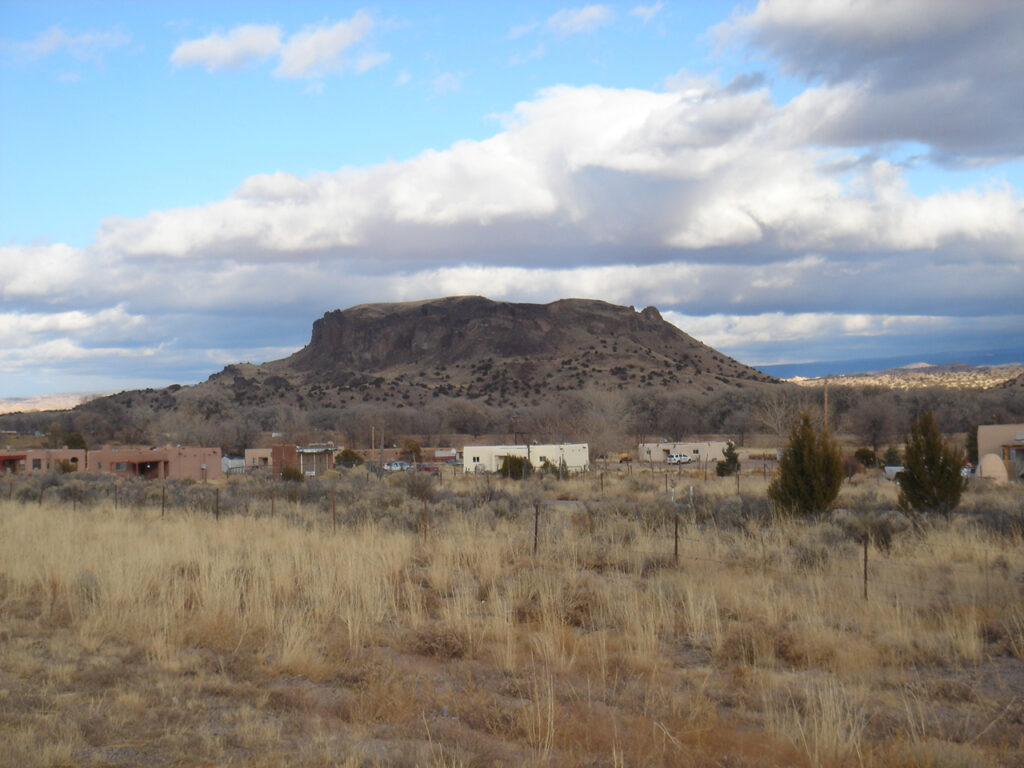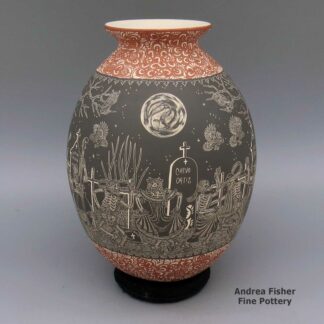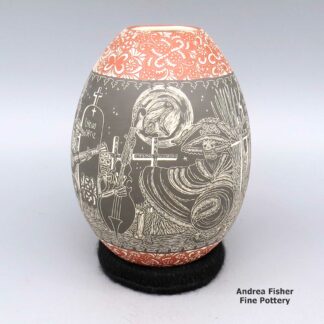| Dimensions | 5.75 × 5.75 × 6 in |
|---|---|
| Condition of Piece | Very good, normal wear |
| Signature | Santana Adam |
Santana Martinez, dksi3c259, Jar with a ring-of-feathers geometric design
$1,700.00
A black-on-black jar decorated with a ring-of-feathers geometric design around the shoulder
In stock
Brand
Martinez, Adam and Santana
Santana Roybal (1909-2002) was born into a different family of well-known San Ildefonso potters and painters. She grew up learning how to make pots from her grandmother, Dominguita Pino Martinez.
Santana and Adam were married in 1926 and they lived in Maria and Julian's home for the next 8 years. During that time Santana learned Maria's way of making pots and Julian's methods of painting them.
After Julian passed away in 1943, Adam and Santana dedicated themselves to helping Maria continue with her business. Adam took over his father's duties with gathering and processing clay and firing pots. Santana worked with Maria making pots and painting them. The signature on most of Maria's pottery made through those years (1943-1956) reads "Marie + Santana". Those years were Maria's most prolific years.
In 1956 Maria began working with her youngest son, Popovi Da. Adam and Santana graduated to making pottery on their own. Their signature became "Santana + Adam".
They were participants every year at the Santa Fe Indian Market from 1970 to 1999, winning several First, Second and Third Place ribbons plus Best of Class and Best of Division. In 1981 they earned the "Maria Poveka Award for Best Traditional San Ildefonso Pottery."
Andrea held an Indian Market Reception in the gallery featuring Adam and Santana on August 16, 1996. It was an evening cherished by all who came.
Adam and Santana had seven children and they taught most of them how to make pottery the traditional way.
Some exhibits that featured Works by Adam and Santana
- Awa Tsireh: Pueblo Painter and Metalsmith. Heard Museum. Phoenix, Arizona. November 4, 2017 - July 1, 2018. Note: curated by Diana F. Pardue and Norman Sandfield; accompanied by a catalog
- A Century of Pueblo Painters: San Ildefonso Pueblo 1900-1999. Adobe Gallery. Santa Fe, New Mexico. March 3, 2017 - April 30, 2017. Group show and sale with the following artists: José Angela Aguilar, Gilbert Atencio, Popovi Da, Tony Da, Louis Gonzales, Julián Martinez, Richard Martinez, Santana Roybal Martinez, José Encarnacion Peña, Tonita Vigil Peña, Tony Pena, Alfonso Roybal, José Disiderio Roybal, Tonita Roybal, Abel Sanchez, Romando Vigil, and Tomacito Vigil.
- Something Old, Something New, Nothing Borrowed: New Acquisitions from the Heard Museum Collection. Heard Museum. Phoenix, Arizona. April 2, 2011 - March 18, 2012
- Gifts from the Community. Heard Museum West. Surprise, AZ. April 12, 2008 - October 12, 2008
- Home: Native Peoples in the Southwest. Heard Museum. Phoenix, AZ. 2005
- The Collection Passions of Dennis and Janis Lyon. Heard Museum. Phoenix, AZ. May 1, 2004 - September 1, 2004
- A Revolution in the Making: The Pottery of Maria and Julian Martinez. Heard Museum. Phoenix, AZ. May 10, 2003 - September 14, 2003
- Hold Everything! Masterworks of Basketry and Pottery from the Heard Museum. Heard Museum. Phoenix, AZ. November 1, 2001 - March 10, 2002
- Passionate Involvement: Recent Acquisitions of the Heard Museum. Heard Museum. Phoenix, AZ. March 1, 2001 - October 1, 2001
- The Legacy of Generations: Pottery by American Indian Women. Heard Museum. Phoenix, AZ. February 14, 1998 - May 17, 1998
- The Legacy of Generations: Pottery by American Indian Women. The Museum of Women in the Arts. Washington, DC. October 9, 1997 - January 11, 1998
- Recent Acquisitions from the Herman and Claire Bloom Collection. Heard Museum. Phoenix, AZ January 11, 1997 - July 1,1997
- 1979 Heard Museum Guild Indian Arts & Crafts Exhibit. Heard Museum. Phoenix, Arizona. November 21, 1979 - December 3, 1979
- 1978 Heard Museum Guild Indian Arts & Crafts Exhibit. Heard Museum. Phoenix, Arizona. November 24, 1978 - December 2, 1978
- The Martinez Tradition. Heard Museum. Phoenix, Arizona. April 29, 1978 - August 30, 1978
- 1977 Heard Museum Guild Indian Arts & Crafts Exhibit. Heard Museum. Phoenix, Arizona. November 25, 1977 - December 3, 1977
- 1969 Heard Museum Guild Indian Arts and Crafts Show. Heard Museum. Phoenix, Arizona. 1969
- 1968 Heard Museum Guild Indian Arts and Crafts Show. Heard Museum. Phoenix, Arizona. 1968
Some Awards earned by Adam and Santana
- 1990 Santa Fe Indian Market, Classification II - Pottery, Division E - Traditional pottery, painted designs on burnished black or red surface, Category 1108 - Plates: Third Place
- 1986 Santa Fe Indian Market, Classification II - Pottery, Division E - Traditional pottery, painted designs on burnished black or red surface: Best of Division with Adam Martinez
- 1986 Santa Fe Indian Market, Classification II - Pottery, Division E - Traditional pottery, painted designs on burnished black or red surface, Category 1101 - Jars up to 8 inches tall: Second Place
- 1986 Santa Fe Indian Market, Classification II - Pottery, Division E - Traditional pottery, painted designs on burnished black or red surface, Category 1103 - Bowls: First Place
- 1984 Santa Fe Indian Market, Classification II - Pottery, Division E - Traditional pottery, painted designs on burnished black or red surface: Best of Division with Adam Martinez
- 1984 Santa Fe Indian Market, Classification II - Pottery, Division E - Traditional pottery, painted designs on burnished black or red surface: Category 1101 - Jars up to 8 inches tall: First Place. Awarded for collaborative artwork with Adam Martinez
- 1983 Santa Fe Indian Market, Classification II - Pottery, Division B - Traditional, undecorated: Third Place
- 1979 Heard Museum Guild Indian Arts & Crafts Exhibit, Classification VII - Pottery, Division A - Traditional methods of construction and firing: Honorable Mention. Awarded for artwork: Mat Design Bowl
- 1978 Heard Museum Guild Indian Arts & Crafts Exhibit, Classification VII - Pottery, Division A - Traditional: First Place shared with Adam Martinez. Awarded for artwork: Wedding jar
- 1978 Heard Museum Guild Indian Arts & Crafts Exhibit, Classification VII - Pottery, Division A - Traditional: Honorable Mention shared with Adam Martinez. Awarded for artwork: Small jar
- 1977 Heard Museum Guild Indian Arts & Crafts Exhibit, Classification VII - Pottery, Division A - Traditional shapes and design: Second Place with Adam Martinez. Awarded for artwork: Large bowl with lid
- 1969 Heard Museum Guild Indian Arts & Crafts Exhibit, Classification X - Pottery, Division A - Traditional as to materials, methods, shape, and design: Third Place
- 1968 Heard Museum Guild Indian Arts & Crafts Show, Classification IX - Pottery, Division A - Traditional materials, methods and design: First Place with Adam Martinez. Awarded for artwork: Feather Design Jug
- 1922 Southwest Indian Fair and Arts and Crafts Exhibition: Drawings of Pottery Designs: Pupils of Pueblo Day School: First Place. National Guard Armory, Santa Fe, New Mexico. September 1922. Note: awarded the Dougan Fund Prize of $2.00
A Short History of San Ildefonso Pueblo

San Ildefonso Pueblo is located about twenty miles northwest of Santa Fe, New Mexico, mostly on the eastern bank of the Rio Grande. Although their ancestry has been traced as far back as abandoned pueblos in the Mesa Verde area in southwestern Colorado, the most recent ancestral home of the people of San Ildefonso is in the area of Bandelier National Monument, the prehistoric village of Tsankawi in particular. The area of Tsankawi abuts today's reservation on its northwest side.
The San Ildefonso name was given to the village in 1617 when a mission church was established. Before then the village was called Powhoge, "where the water cuts through" (in Tewa). The village is at the northern end of the deep and narrow White Rock Canyon of the Rio Grande. Today's pueblo was established as long ago as the 1300s and when the Spanish arrived in 1540 they estimated the village population at about 2,000.
That first village mission was destroyed during the Pueblo Revolt of 1680 and when Don Diego de Vargas returned to reclaim the San Ildefonso area in 1694, he found virtually the entire tribe on top of nearby Black Mesa, along with almost all of the Northern Tewas from the various pueblos in Tewa Basin. After an extended siege, the Tewas and the Spanish negotiated a treaty and the people returned to their villages. However, the next 250 years were not good for any of them.
The Spanish swine flu pandemic of 1918 reduced San Ildefonso's population to about 90. The tribe's population has increased to more than 600 today but the only economic activity available for most on the pueblo involves the creation of art in one form or another. The only other jobs are off-pueblo. San Ildefonso's population is small compared to neighboring Santa Clara Pueblo, but the pueblo maintains its own religious traditions and ceremonial feast days.

Photo is in the public domain
About Jars
The jar is a basic utilitarian shape, a container generally for cooking food, storing grain or for carrying and storing water. The jar's outer surface is a canvas where potters have been expressing their religious visions and stories for centuries.
In Sinagua pueblos (in northern Arizona), the people made very large jars and buried them up to their openings in the floors of the hidden-most rooms in their pueblo. They kept those jars filled with water but also kept smaller jars of meat and other perishables inside those jars in the water. It's a form of refrigeration still in use among indigenous people around the world.
Where bowls tend to be low, wide and with large openings, jars tend to be more globular: taller, less wide and with smaller openings.
For a potter looking at decorating her piece, bowls are often decorated inside and out while most jars are decorated only on the outside. Jars have a natural continuity to their design surface where bowls have a natural break at the rim, effectively yielding two design surfaces on which separate or complimentary stories can be told.
Before the mid-1800s, storage jars tended to be quite large. Cooking jars and water jars varied in size depending on how many people they were designed to serve. Then came American traders with enameled metal cookware, ceramic dishes and metal eating utensils...Some pueblos embraced those traders immediately while others took several generations to let them and their innovations in. Either way, opening those doors led to the virtual collapse of utilitarian pottery-making in most pueblos by the early 1900s.
In the 1920s there was a marked shift away from the machinations of individual traders and more toward marketing Native American pottery as an artform. Maria Martinez was becoming known through her exhibitions at various major industrial fairs around the country and Nampeyo of Hano was demonstrating her art for the Fred Harvey Company at the Grand Canyon. The first few years of the Santa Fe Indian Market helped to solidify that movement and propel it forward. It took another couple generations of artists to open other venues for their art across the country and turn Native American art into the phenomenon it has become.
Today's jars are artwork, not at all for utilitarian purposes, and their shapes, sizes and decorations have evolved to reflect that shift.
About Geometric Designs
"Geometric design" is a catch-all term. Yes, we use it to denote some kind of geometric design but that can include everything from symbols, icons and designs from ancient rock art to lace and calico patterns imported by early European pioneers to geometric patterns from digital computer art. In some pueblos, the symbols and patterns denoting mountains, forest, wildlife, birds and other elements sometimes look more like computer art that has little-to-no resemblance to what we have been told they symbolize. Some are built-up layers of patterns, too, each with its own meaning.
"Checkerboard" is a geometric design but a simple black-and-white checkerboard can be interpreted as clouds or stars in the sky, a stormy night, falling rain or snow, corn in the field, kernels of corn on the cob and a host of other things. It all depends on the context it is used in, and it can have several meanings in that context at the same time. Depending on how the colored squares are filled in, various basket weave patterns can easily be made, too.
"Cuadrillos" is a term from Mata Ortiz. It denotes a checkerboard-like design using tiny squares filled in with paints to construct larger patterns.
"Kiva step" is a stepped geometric design pattern denoting a path into the spiritual dimension of the kiva. "Spiral mesa" is a similar pattern, although easily interpreted with other meanings, too. The Dineh have a similar "cloud terrace" pattern.
That said, "geometric designs" proliferated on Puebloan pottery after the Spanish, Mexican and American settlers arrived with their European-made (or influenced) fabrics and ceramics. The newcomers' dinner dishes and printed fabrics contributed much material to the pueblo potters design palette, so much and for so long that many of those imported designs and patterns are considered "traditional" now.
Maria Martinez Family Tree - San Ildefonso Pueblo
Disclaimer: This "family tree" is a best effort on our part to determine who the potters are in this family and arrange them in a generational order. The general information available is questionable so we have tried to show each of these diagrams to living members of each family to get their input and approval, too. This diagram is subject to change should we get better info.
- Reyes Peña (d. 1909) & Tomas Montoya (d. 1914)
- Maria Montoya Martinez (1887-1980) & Julian Martinez (1884-1943)
- Adam Martinez (1903-2000) & Santana Roybal Martinez (1909-2002)
- George Martinez (1943-) & Pauline Martinez (Santa Clara)(1950-)
- Anita Martinez (d. 1992) & Pino Martinez
- Barbara Tahn-Moo-Whe Gonzales (1947-) & Robert Gonzales
- Aaron Gonzales (1971-)
- Brandon Gonzales (1983-)
- Cavan Gonzales (1970-)
- Derek Gonzales (1986-)
- Kathy Wan Povi Sanchez (1950-) & Gilbert Sanchez (San Juan)
- Corrine Sanchez
- Gilbert Abel Sanchez
- Liana Sanchez
- Wayland Sanchez
- Evelyn Than-Povi Garcia
- Myra Garcia
- Berlinda Garcia
- Myra Garcia
- Peter Pino
- Barbara Tahn-Moo-Whe Gonzales (1947-) & Robert Gonzales
- Viola Martinez/Sunset Cruz & Johnnie Cruz Sr.
- Beverly Martinez (1960-1987)
- Marvin Martinez (1964-) & Frances Martinez
- Johnnie Cruz Jr. (1975-)
- George Martinez (1943-) & Pauline Martinez (Santa Clara)(1950-)
- Popovi Da (1921-1971) & Anita Da
- Tony Da (1940-2008)
- Adam Martinez (1903-2000) & Santana Roybal Martinez (1909-2002)
- Desideria Montoya (1889-1982)
- Maximiliana Montoya (1885-1955) & Cresencio Martinez (1879-1918)
- Juanita Vigil (1898-1933) & Romando Vigil (1902-1978)
- Carmelita Vigil (1925-1999) & Nicholas Cata
- Martha Appleleaf (1950-)
- Erik Fender (1970-)
- Gloria Maxey (d. 1999)
- Angelina Maxey (1970-)
- Jessie Maxey (1972-)
- Martha Appleleaf (1950-)
- Carmelita Vigil Dunlap (1925-1999) & Carlos Dunlap (d. 1971)
- Carlos Sunrise Dunlap (1958-1981)
- Cynthia Star Flower Dunlap (1959-)
- Jeannie Mountain Flower Dunlap (1953-)
- Linda Dunlap (1955-)
- Carmelita Vigil (1925-1999) & Nicholas Cata
- Maria Montoya Martinez (1887-1980) & Julian Martinez (1884-1943)






